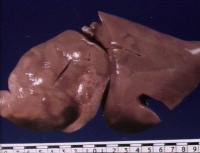Canine Adenovirus 2
Also known as: Infectious Canine Laryngotracheitis — CAV-2
Introduction
Both Canine Adenovirus 1 and Canine Adenovirus 2 are of the Adenoviridae and are now rare in the UK. There is some antigenicty shared between the two strains, which lends itself to vaccination.
Infection spreads rapidly between unvaccinated dogs, especially if they are in groups e.g. in kennels. Transmission is by direct and indirect contact such as food bowls and bedding (fomites) and respiratory secretions.
The virus replicates in the oropharynx then causes necrosis of the respiratory tract with NO concurrent hepatitis. Lung lesions may be worsened by presence of Bordetella bronchiseptica and Pasteurella multocida. It is thought that this virus may be a predisposing factor to the development of kennel cough. It may also cause necrotising bronchiolitis in immunodeficient dogs.
Signalment
Dogs of any age, breed or sex will be equally affected by this virus if not vaccinated.
Clinical Signs
Animals present with pyrexia, mild depression, nasal/ocular discharges and a dry, harsh, persistent cough. Corneal opacity is sometimes seen.
Diagnosis
Virus can be isolated from respiratory secretions early in the disease.
Pathology
There is usually evidence of mild bronchointerstitial pneumonia, necrosis of bronchiolar and alveolar epithelium, oedema and type II pneumocyte hyperplasia.
Control
It is important to isolate coughing dogs and disinfect premises, in any cases of coughing as all respiratory disease is contagious.
CAV-2 is largely controlled in the UK along with CAV-1 (infectious canine hepatitis virus) through the use of vaccination against CAV-1. As the viruses cross-protect, immunity is achieved from vaccinating against CAV-1.
References
Blood, D.C. and Studdert, V. P. (1999) Saunders Comprehensive Veterinary Dictionary (2nd Edition) Elsevier Science
Bridger, J and Russell, P (2007) Virology Study Guide, Royal Veterinary College
Merck & Co (2008) The Merck Veterinary Manual (Eighth Edition) Merial
Nelson, R.W. and Couto, C.G. (2009) Small Animal Internal Medicine (Fourth Edition) Mosby Elsevier
| This article has been peer reviewed but is awaiting expert review. If you would like to help with this, please see more information about expert reviewing. |
Error in widget FBRecommend: unable to write file /var/www/wikivet.net/extensions/Widgets/compiled_templates/wrt69552a4d3574f6_43428246 Error in widget google+: unable to write file /var/www/wikivet.net/extensions/Widgets/compiled_templates/wrt69552a4d451dd5_17903789 Error in widget TwitterTweet: unable to write file /var/www/wikivet.net/extensions/Widgets/compiled_templates/wrt69552a4d55ad49_71377761
|
| WikiVet® Introduction - Help WikiVet - Report a Problem |
